Citizens' forums, and attitudes to agriculture, environment and rural priorities: research report
Results of an independent study into Scottish public attitudes to the environment, agriculture and rural development.
Appendix D: Findings from Citizens' Forums
The two Citizens' Forums convened as part of this research project were held on 16-17 February and 2-3 March 2019. One Forum was in a predominantly rural location (Montrose) and another in a predominantly urban location (Motherwell). The 49 individuals that participated in the Forum were recruited to be broadly representative of the demographics on the population.
Each Citizens' Forum took participants through a structured process of leaning, dialogue and deliberation designed to produce clear, collective outputs. The rationale for this approach, the results, and a summary of the discussions that underpinned them, are presented in this report.
Methodology
Citizens'' Forums are becoming increasingly recognised as an effective and meaningful way of engaging people in policy and decision-making processes by:
- giving decision-makers a detailed understanding of informed public opinion on complex issues and/or value-laden and controversial questions; and
- opening up the political space for consensus, for trade-offs to be made and a solution to be found.
This is because it is a method that employs a distinctive deliberative approach to public engagement. As such it differs from other forms of consultation in that it is about giving participants time to learn about and discuss an issue in depth and then come to an informed and considered view.
The defining characteristic of a Citizens' Forum is that it brings together a fairly large group of Citizens', selected to be broadly representative of the demographics of the population, to deliberate on a significant public policy issue. The Forum involves a 3-stage process:
- A dedicated learning phase: A central feature of a Citizens' Forum process is the learning component wherein participants are able to develop an understanding of the issue based on unbiased information and/or the clear presentation of arguments from different perspectives. Information can be presented in a variety of ways including presentations from experts, written information and through facilitated discussions. Because of this focus given to learning about an issue before being asked to form an opinion, Citizens'' assemblies are able to address quite complicated and technical issues.
- Discussion focussed on developing dialogue: Participants are then supported by facilitators to engage in dialogue about the topic (usually in small groups). This allows time for people to develop and test opinions on issues that are new to them (and on which they do not have a pre-existing opinion), explore their pre-existing opinions in light of what they have heard and encourages a wider understanding of the opinions of others. Experts will often be on hand during this phase to provide additional information and/or clarification, but not opinions.
- The deliberation phase: This stage of the Forum involves participants coming to some conclusions based on what they have learnt through a process of public reasoning. While consensus based decision-making processes are the ideal, at this stage voting systems (or a combination of both) are often used to reach conclusions, prioritise options, establish collective outputs and/or make recommendations
Given the research objectives of exploring public priorities to agriculture, environment and rural community issues, the following sequence of deliberation was deployed at the Forums:
'Scottish farming provides a vital public service to the people of Scotland'
Quantitative and qualitative responses re level of agreement and direction of change of viewpoint after discussion
The importance of factors such as cost, quality, animal welfare and local production underpinning food consumption choices - and where the trade-offs would be made individually
Quantitative and qualitative responses re overall priorities as well as the results from forced binary choice trade-offs e.g. between environmental impacts or quality, health benefits or animal welfare
Perceptions of the impact of farming on the natural environment and biodiversity, and 'whether it is the responsibility of farmers to do more?'
Quantitative responses to the primary question as well as re the specific responsibility to do more to protect soil quality, water quality, air quality, biodiversity and reduce C02 emissions Qualitative responses re overall perceptions of impact and the impacts of different farming models on the landscape (i.e. the balance of 'natural beauty' vs land productivity)
What are the principles that should be at the core of the agricultural sector in Scotland?
A list of 10 negotiated and ranked principles (from each Forum), developed as baseline criteria to rank other options
Preferences for how replacement CAP funding for farmers is distributed, and the priority that should be given to different factors in the future
A qualitative assessments of the pros and cons of each option Ranked preferential votes (from each Forum as well as cumulatively)
Preferences for the balance of replacement CAP spending, with a particular focus on the balance between support for farmers, environmental enhancement, and support for rural communities?
A qualitative assessments of the pros and cons for various propositional weighting of funds Ranked preferential votes (from each Forum as well as cumulatively)
Comparative survey responses
Pre and post deliberation responses to most questions in the c.2345 people national survey undertaken before the Forums
The expert input to the Forums, included presentations on the following topics:
- The value of Agriculture in Scotland - Professor David Hopkins (SRUC)
- The impact of Farming on the Environment - Professor Davy McCracken (SRUC)
- Agriculture and the Landscape - Katrin Prager (University of Aberdeen)
- What is the Common Agricultural Policy (CAP) and how CAP funds are allocated? - Professor David Hopkins (SRUC)
- How could environmental management by land managers be funded differently? - Professor Davy McCracken (SRUC)
Participants
The goal of the Citizens' Forums was to bring together 50 people, broadly representative of Scotland's population, across 2 locations - with one focusing on a more urban constituency (in Motherwell) and one focusing on a more rural constituency (in Montrose) - that cumulatively would give a balanced representation of the demographics across the country i.e. together be a 'mini-public'. Although, given the small numbers involved, the participants could not be considered to be statistically representative of the population, the intent was to stratify the recruitment to ensure as representative sample as possible.
Participants were primarily recruited from the people who responded to the national survey, where an option of indicating interest and availability for future research involvement was included. Given the Citizens' Forums were designed to bring in people from a reasonably small geographic area (1-1.5 hours travel time from the location of the meeting) when the responses to the survey did not happen to provide a significantly diverse sample within the target geography, additional participants were invited to supplement the sample group using targeted 'free-find' recruitment methods.
27 participants were recruited for the Citizens' Forum in Motherwell (in the hope that, accounting for last minute cancellations, this would lead to the attendance of at least 25). Following an unusually high non-attendance rate at this first meeting (only 22 of the 27 confirmed participants attended), a larger number were recruited for the Montrose Citizens' Forum to ensure the final number of participants was as close to 50 as possible (32 were invited and 28, dropping to 27 on the 2nd day, attended).
Demographic spread of attendees
Overall 49 participants took part in the Citizens' Forums, the demographic profile of participants.
Demographic profile of Citizens' Forum participants
| Motherwell | Montrose | Target demographics | Attendees overall[80] | |
|---|---|---|---|---|
| Gender | ||||
| Female | 10 | 13 | 51% | 47% |
| Male | 12 | 14 | 49% | 53% |
| Age | ||||
| 16-34 | 5 | 6 | 30% | 22% |
| 35-44 | 4 | 4 | 15% | 16% |
| 45-54 | 5 | 5 | 17% | 20% |
| 55-64 | 4 | 3 | 16% | 14% |
| 65+ | 4 | 9 | 22% | 27% |
| Social Grade | ||||
| ABC1 | 10 | 12 | 50% | 45% |
| C2DE | 12 | 15 | 50% | 55% |
| Urban-rural[81] | ||||
| Urban | 14 | 9 | 70% | 47% |
| Rural | 8 | 18 | 30% | 53% |
| Total | 22 | 27 | ||
Does Scottish farming provide a vital public service to the people of Scotland?
The learning phase of each of the Citizens' Forums began with a presentation by Professor David Hopkins, Dean of the Central Faculty of Scotland's Rural College. This presentation outlined the contribution agriculture makes to the Scottish economy and the nature of the agricultural sector in Scotland.
Following this, the first question participants were asked to focus on was whether they agreed that Scottish farming provides a vital public service to the people of Scotland, and why? This question was taken straight from the the national survey where the results showed that overall, 83% agreed with this statement. The purpose of taking this question to the Forums was to try and understand this high level of agreement further.
Initial reactions from the vast majority of participants in both locations showed high levels of agreement with the statement that 'Scottish farming provides a vital public service'. Four individuals however were decidedly less convinced, questioning why this particular sector should be considered more important than other sectors across Scotland.
In discussions, some of the reasons behind agreeing or strongly agreeing with the statement were linked to the "financial benefit to the economy." Participants pointed to the jobs it creates and in particular providing "vital employment to rural communities." They also mentioned that "if it is well managed," farming can have a positive "impact on the environment," including "maintaining waterways," and "keeping soil fertility," among other aspects.
Food production was another theme that appeared in discussions, with a sense that Scottish farming is a vital public service towards Scotland "be[ing] able to produce own food and not rely on other countries and policies." Buying Scottish food "to support local farming" was highlighted by participants as well as it being perceived that Scottish farming produces high quality food because food sourced from Scotland "is fresher, healthier and it supports the ecosystems."
Another important aspect that came out in discussions was a sense that Scottish farming is a vital public service because it is linked to Scottish identity and has historical significance. Farmers were described as "keepers of our countryside," and that farming is a part of this "historical landscape and identity, there to be cultivated," with a responsibility to "retain historic skills/crofts that would otherwise be lost to future generations."
Participants were also asked to think about reasons against Scottish farming being a vital public service. They identified "income / expenditure in today's climate does not contribute enough to the economy", that "most food produce is imported" and that they sense there is a disparity between "very poor and very rich farmers," as being potential reasons behind disagreeing with the statement.
After the discussions, everyone was asked to indicate whether they now more strongly, or less strongly agreed with the statement:
- 29% moved towards more strongly agreeing;
- 52% stayed at the same level of agreement;
- 19% moved towards less agreement.
When this question was revisited in the research survey at the end of the weekend, after 2 days of deliberation around the topic, participants again showed very high levels of agreement (90%), notably higher than the results from the national survey as a whole.
Scottish farming provides a vital public service to the people of Scotland
| Strongly agree % | Tend to agree % | Neither nor % | Tend to disagree % | Strongly disagree % | |
|---|---|---|---|---|---|
| Survey | 46% | 40% | 8% | 3% | 1% |
| 1st response Motherwell | 91% | 5% | 5% | 0% | 0% |
| 1st response Montrose | 35% | 46% | 15% | 4% | 0% |
| After 2 days deliberation | 51% | 39% | 8% | 0% | 0% |
Food, diet and consumption habits
Reactions to the national survey
To stimulate discussion on this topic participants in the Citizens' Forums were introduced to the results of the national survey relating to the factors that were considered 'essential' or 'very important' in 'choosing what you eat'. Participants were asked whether the results 'rang true' with their own thoughts on what is important for them when choosing food, before exploring more directly the importance of factors such as cost, quality, and local production, environmental concerns, and special diets in underpinning choices of food.
In these early discussions, participants from Motherwell identified that "health campaigns" such as the "sugar tax made us more aware" of food's impact on health - the factor that 59% of survey respondents had said was essential or very important. In Montrose, participants expressed surprise that animal welfare was not a higher consideration for people but concluded that this might be because people "don't think about animal welfare because they assume it is high welfare [in the UK]."
Citizens' Forum participants in Motherwell and Montrose were also particularly surprised by the low percentage identifying convenience and speed of food as an important factors. They pointed at lifestyle changes in Scottish society such as changing "work patterns" affecting people's priorities and lifestyle patterns regarding food consumption, suggesting that this has resulted in a much higher consumption of quick, easy and pre-prepared foods. The importance given to the convenience factor was also related to ease in terms of "fussy families," and that for some people it's a lack of "knowledge about how to prepare food" or that they "can't cook, won't cook, or don't have access" to cooking facilities.
Both Motherwell and Montrose participants also noted their surprise that the cost of food was not identified by more people as being essential or very important when choosing food. They said that while maybe this was because "cost is going to be more important to some people than others" and "depends on budget." Issues like "food poverty" and the growing prevalence of food banks in response to this were also seen as important to consider.
There was some surprise by how low down the list specific dietary requirements, and religious background and cultural practices, were in the survey responses. Citizens' Forum participants explained that they thought "that dietary requirements...seems a growing factor, medical or choice", and that in their experience many "people are choosing more restricted diets" for ideological or health reasons (eg veganism or gluten free diets) "whereas in the past people ate what they ate."
They also expressed surprise that environmental impacts were considered essential or very important by only 35% of survey respondents "given higher awareness" of this issue amongst the public more generally.
Factors in food choices
To explore this question further, and avoid the tendency to place importance on everything that can emerge through discussions like this, participants in the Citizens' Forums were asked to consider what influences their food choices through a series of binary choice questions. This was designed to force participants to make a trade off between the factors in order to identify what really was most influential in their food choices.
To make the considerations less abstract, and to try to link them to real everyday choices that people make, each option was presented as a specific shopping consideration. For example:
- You are in the supermarket buying a ready-meal for your dinner. Which is going to have a greater impact on your choice - Healthier or Cheaper?
- You are buying a chicken to roast for a family dinner. Which is going to have the biggest impact on your choice - Cost or Animal Welfare?
- You are shopping for cheese. For the same price you have the choice of something locally produced or an imported one that you believe likely to be better quality?
The results of these binary votes, and the reasons behind these choices are presented below.
Healthier Food vs Cheaper Food
Participants were asked first about whether healthier food or cheaper food was more important when they make food choices.
Overall, over half the participants from both Citizens' Forums decided that health aspects had a greater impact on their choice of food than if was cheaper. In Motherwell, 59% said that healthy food had a greater impact on their choice and in Montrose this rose to 64% of participants.
Healthier vs Cheaper choices
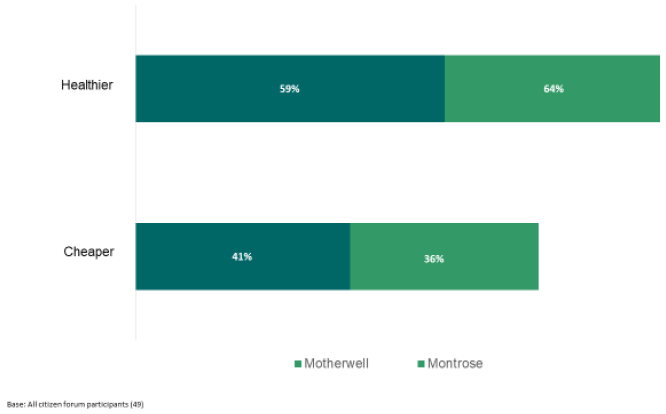
When discussing the results in groups, participants recognised that "it depends on income," and that people might have to choose cheaper food because the "costs are high and living wage is not enough". There was also some acknowledgement within the groups that people (including themselves) may have been influenced in their answer to this question by the fact that 'healthier' is the more socially expected answer, rather than one that they may always implement in practice.
Participants noted that "people have different ways of shopping," that can influence this choice (eg. big supermarket shop weekly/fortnightly compared to using local bakers, butchers, green grocers etc more regularly. Participants also noted that "healthier is not always expensive" despite the widely held perception that fresh food costs more.
Cost vs Animal Welfare
Participants were then asked if the cost of food or animal welfare was the more important factor in their food choices. Here Citizens' Forum participants were more or less evenly split. While participants in Motherwell split exactly 50-50, slightly more than half of the participants in Montrose (57%) said the cost of food had a greater impact.
In discussions, participants pointed to "supermarket deals" and their "habit to pick up the cheaper one of two options" as being why cost has an impact on their food choices. Participants said that "people don't know/switch off to what animal welfare means" although this might "depend where you come from - rural/urban" and your experience of actually seeing how farm animals are treated. One table particularly highlighted in their conversation that the variety of words to describe different animal welfare standards can lead to mistrust of such food labelling and result in it becoming less of a consideration when shopping.
Costs vs Animal Welfare
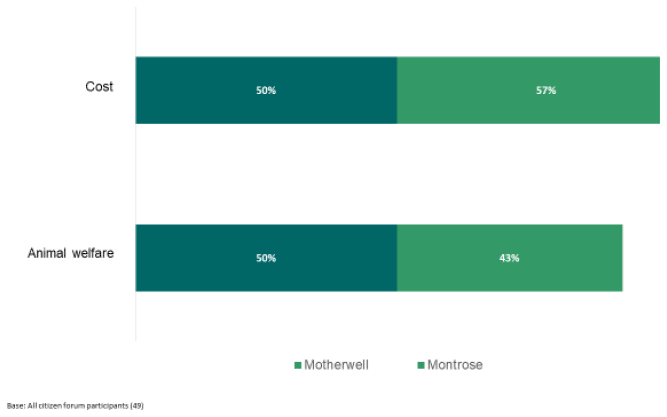
Healthier Food vs Food that is better for the Environment
Citizens' Forum participants were clear in deciding that choosing healthier food had a greater impact on their choices than whether the food was better for the environment. In both locations the vast majority (85%/86%) voted in favour of healthier food, and only 14%-15% stated that they would choose food that was better for the environment.
Healthier vs Better for the environment
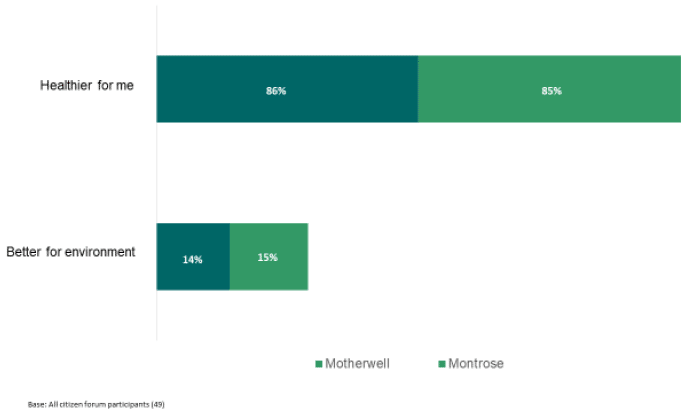
In conversations around this choice, participants highlighted that when buying food "you think of yourself first" and that considerations about the "environmental aspect is much broader" and "more removed" for people i.e. most "people are not as linked to the land and don't consider how food gets to their plate."
Locally Produced Food vs Better Quality Food
Overall, the Citizens' Forum chose locally produced food as having a greater impact on their choice than the quality of the food. This was more pronounced in Motherwell where 64% of the participants said locally produced food had a greater impact on their choices. In Montrose however, more participants stated they would chose food because it was better quality, although overall Montrose was more evenly split than in Motherwell.
Locally produced food vs Better quality
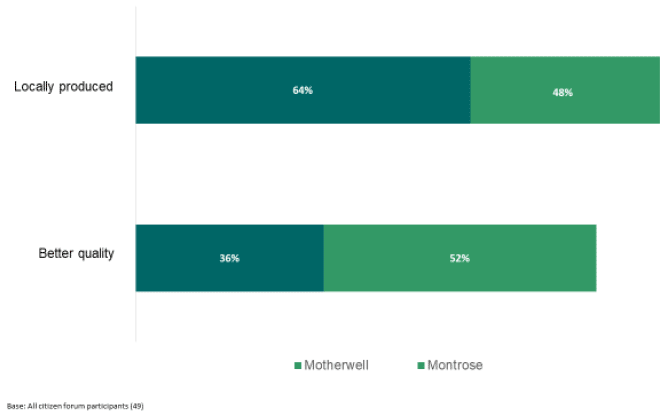
Discussions from both locations revealed that for participants, their preference for locally produced food was because it is "important for local business". They said that, for them, "locally-sourced implies high quality" and that "Scotland equals quality". When discussions turned to fresh local produce there was a strong consensus that they would prefer to buy locally grown produce because it would be fresher, even if visually that means buying "wonky veg." One caveat from participants was that while they "want to support local producers, but not if it is not as good".
Food that is better for the Environment vs Better Animal Welfare
Overall, the Citizens' Forums chose better animal welfare as having a greater impact upon their choice of food than consideration for the environment. In 'urban' Motherwell, 57% of participants felt animal welfare had a greater impact while in 'rural' Montrose, almost three quarters of participants said animal welfare was greater consideration than the environment more widely on their choice of food.
Better for the Environment vs Better animal welfare
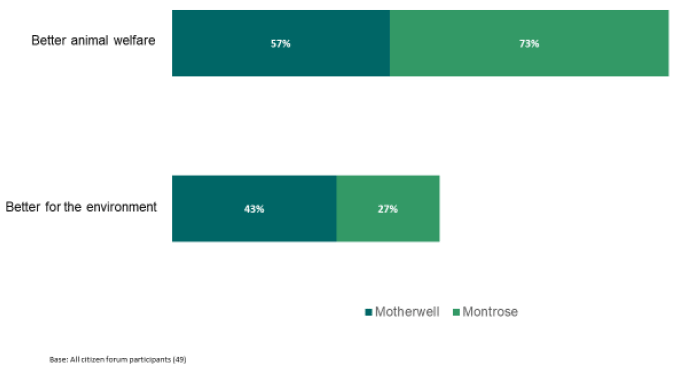
Participants reflected that they felt that often the two aspects went hand-in-hand and that "good environmental protection equals good animal welfare, but bad environmental protection equals bad animal welfare." Participants also noted that in their minds, "high animal welfare equals better quality food" which may help to explain why animal welfare wins out over the environment when presented with a binary choice.
Some participants, particularly from Montrose felt that the results of the question might be different if more people were actually more exposed to the conditions that livestock are reared in and the slaughter of animals because "people are not as linked to the land and don't consider how food gets to their plate."
Overall priorities on food choices
Given the activity undertaken it is useful to compare the relative importance given to these factors before and after participants were put in a position of having to actively consider the trade-offs they make when making choices about food consumption. The graph below shows the differences in priority given to food choice factors at the beginning and end of the weekends - i.e. between initial polling reactions and the considered opinions formed after 2 days focussing on the subject.
From this graph it is clearly evident where learning and deliberation has had an impact on participants' priorities. Following the learning and discussion phase the most significant change of opinion is in relation to greater priority being given to the environmental impacts of the agricultural sector - with 23% more participants following their deliberations now considering this to be an essential or very important aspect of their behaviour in relation to food choices. The importance given to food having a 'quality assurance label' in this second vote can also be attributed to the discussions that had taken place about animal welfare and quality (eg organic and/or free range production practices).
Priorities when making food choices
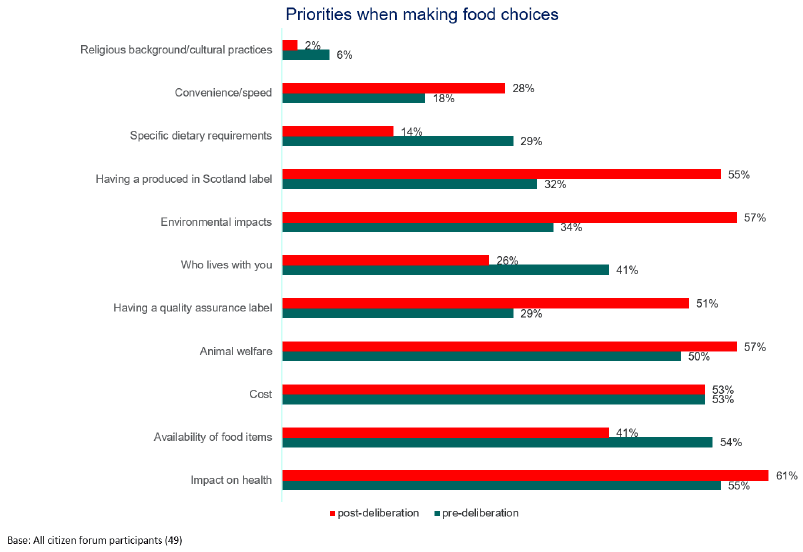
Another aspect of consideration in food choices that showed considerable change over the course of the weekend deliberations is the priority given to where food is produced. In the pre-deliberation survey almost ¼ of participants indicated that they didn't care where the food they ate was produced.
Pre-deliberation responses to the importance of where their food is produced
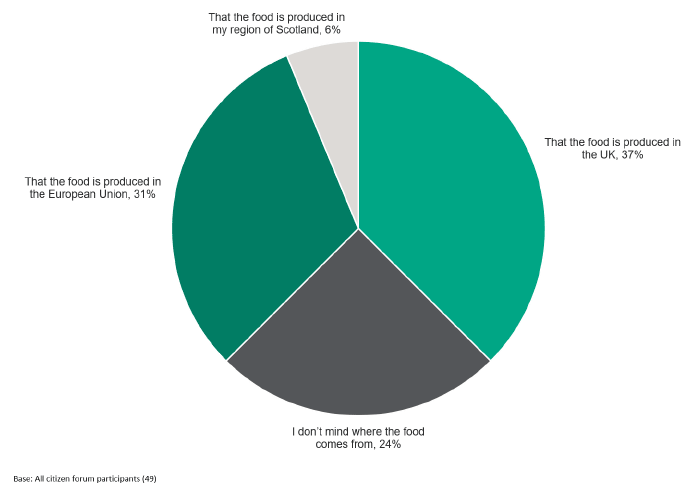
When the same question was asked at the end of the weekend, after the origins of the food people chose had been the subject of much discussion and deliberation, the results were quite different. Here almost half of the participants stated that it was important to them that the food they chose was produced in Scotland, with a further 18% stating that is was important to them that their food was produced in the UK.
Post-deliberation responses to the importance of where their food is produced
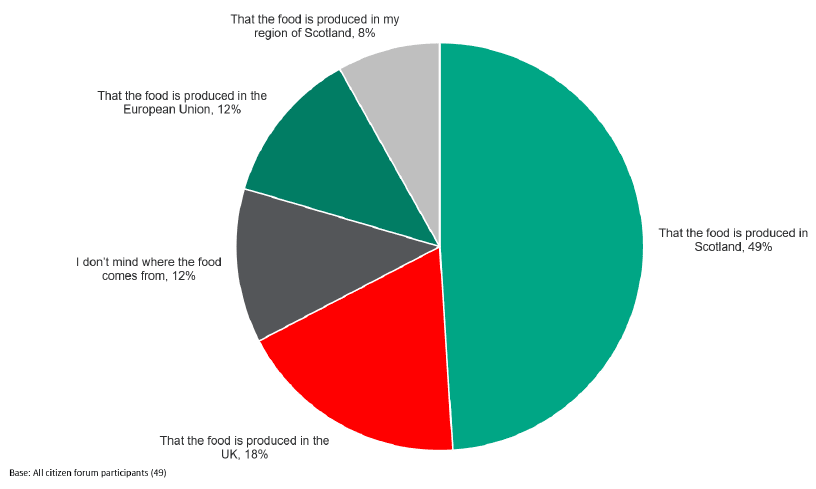
Farming and the environment
To shift the focus away from food specifically and open up wider consideration of the agricultural sector, the participants heard from Davy McCracken, Professor of Agricultural Ecology at Scotland's Rural College about the impacts and responsibilities of farming for the environment.
Citizens' Forum participants were then asked to assess whether or not it is the responsibility of the farming sector to do more to protect and conserve the environment including water, air quality, soil, biodiversity and carbon dioxide (CO2) reductions. These discussions were followed by a series of on-line polls to capture both the average level of support and the range of positions.
Does the farming sector needs to do more to protect and conserve the environment?
For this question, participants were aksed to identify, on a scale of one to ten (1 = strongly disagree and 10 = strongly agree) whether they felt the farming sector needs to do more to protect and conserve the environment overall.
Figure 4.2: Is it the responsibility of the farming sector to do more to protect and conserve the environment
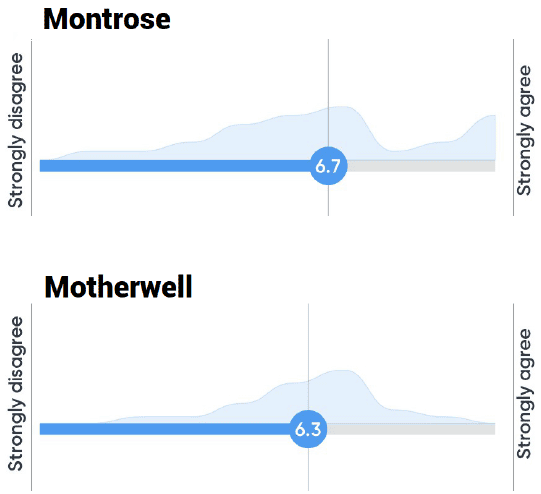
The average results in Motherwell and Montrose both showed a slight leaning towards agreeing with the statement. In Motherwell, the results concentrating around the average result of 6.3. In Montrose however, despite a similar overall result of 6.7, there was a larger spread of votes across the scale with a significant amassing of participants saying they strongly agree that the farming sector needs to do more to protect and conserve the environment.
Participants' main reasons for agreeing that farmers needed to do more to protect the environment was because it is "in their own interests", its their "bread and butter". Another key point highlighted was that "farmers are custodians of the countryside," "they work the land therefore it is their responsibility" and that, for the wider good they therefore have a "responsibility not to be reckless".
On the other hand, some participants suggested farmers also had a right to achieve "returns first" and "need to be cost effective - operating like a business." It was recognised that in some cases expectations regarding environmental protection are "costing farmers because Scottish Government policy has higher climate targets," and that "many demands of farmers means it is complicated."
It was also noted in the discussions that "the market dictates practices" In a context of growing public concern about our environmental impacts there is "wider peer pressure from the sector and consumers" in favour of environmentally friendly products. This has a natural impact on what the public would expect from the farming sector, as it has on what the public expects from other industries in terms of how they mitigate their environmental impacts.This was reflected in comments that focussed on why farmers should not be required to do more to protect the environment (as long as they were compliant with existing standards) because it is "everyone's responsibility" which requires "collective change (e.g. industry)."
The responsibility of the farming sector to do more for specific aspects of the environment
The Citizens' Forums were also asked about the extent to which the farming sector needs to do more to protect and conserve specific aspects of the environment: soil quality; air quality; water quality; biodiversity ; and reductions in carbon dioxide.
The participants in Montrose consistently agreed or strongly agreed more than those in Motherwell with the need for farmers to do more to protect and conserve all of the aspects presented.
Figure 4.3: Is it the responsibility of the farming sector to do more to protect and conserve the environment
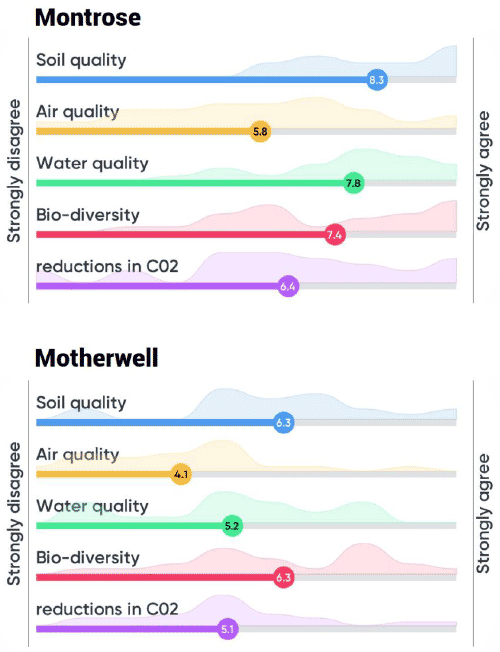
While both locations agreed that the farming sector should do more to protect and conserve soil quality, Montrose participants more strongly agreed (8.3) than in Motherwell (6.3) where there was a wider spread of votes. The main reasons given here related to the fact that maintaining the quality of the land itself is fundamentally the responsibility of those who are using it for their business and thus a specific responsibility of the farming sector.
With regards to air quality, Montrose participants agreed that farming sector needs to do more to protect and conserve air quality (5.8), while those in Motherwell disagreed (4.1). In this case, Montrose participants were more widely spread across the spectrum whereas Motherwell participants clustered around disagreeing. The key reasons given for disagreeing wer that this was a societal wide problem and that the farming sector did not have a specific responsibility for given that the impacts on air quality from this sector were not particularly related to specific farming practices.
Montrose participants strongly agreed (7.8) that the farming sector needs to do more to protect and conserve water quality, whereas in Motherwell participants were more evenly split (5.2). Key reasons given in Montrose for prioritising this aspect of environmental protection related to potential for the run-off of fertilizer and other chemicals and soil from fields to damage the quality of local water courses. This may have been prioritised more highly in Montrose as, being a relatively rural environment, participants had seen more directly the impacts when environmental protection measures on farms had not maintained high standards.
Both locations agreed that farming sector should do more to protect and conserve biodiversity , although Montrose (7.4) was far stronger in agreement than in Motherwell (6.3) where the spread of votes was more even. Again the priority given to this related to the ability of the farming sector to make a direct contribution because of their direct control of how the land they farmed was used. As noted in many of the discussions, the growth of more intensive farming practices has had a direct impact on biodiversity by reducing the range of habitats as more land was cultivated. As the impacts of this are becoming more widely understood there is a corresponding responsibility on the sector to ensure that their land management practices adapt to rectify this.
Montrose participants agreed that the farming sector should do more towards reductions in CO2 (6.4) while participants in Motherwell were more undecided (5.1). Again this was generally seen as a wider societal issue that all people and industries had a responsibility to address. Where people did give a specific responsibility to the farming sector reasons tended to focus on the impacts created by transporting produce (i.e. food miles) and the methane produced by livestock farming (although it was acknowledged there was little that could be done to reduce this other than stop rearing animals for food).
Agriculture and the Landscape
On the Saturday afternoon participants had the chance to hear from Katrin Prager, from the University of Aberdeen who reminded them that what we often think of as Scotland's natural landscape is actually the result of many centuries of decsions and choices about farming and agricultural production. She highlighted the impacts on the landscape of different choices that could be made in Scotland's agricultural future and reminded participants that the countryside views that we are familiar with are made up of a multitude of elements - from fencelines, buildings, hedgerows and trees to provide shelter - that combine to be something that is culturally 'pleasing to the eye'.
This was the most abstract concept that the participants were asked to consider over the weekends and thus findings from these discussions are less clearly quantifiable. Throughout the discussions however some clear themes emerged as people considered how they related to the rural landscape and the things they valued about it.
It was clear in both of the Forums that the participants valued Scotland's rural landscape, and it was noted that, even from within our major cities, it is quite easy to access the rural countryside. The farming landscape was valued both from a scenic standpoint and for the opportunities it provides to get out into the open and enjoy the fresh air, "the noises of nature" and a "sense of tranquillity" that "refreshes the mind and changes the mindset." The tradition of 'rights of way' through farmland which makes this access easy was also valued, although participants' did recognised that not everyone who uses this right respects that the fields are someone's workplace and the foundation of their livelihood.
Participants highlighted that the diversity in our farmlands create "a personality" that means that you not only know that you are in Scotland but know where in Scotland you are. The field structures are different and that gives each part of the country an identity and, as one participant noted, "even if you were blindfolded and dropped in a field you'd know whether you were in Fife, the Borders or on the west coast."
The importance of our mixed farming industry to people came out quite strongly in these discussions, with many participants reflecting on how much they enjoyed the views of different fields as "a patchwork of colours, shapes and smells". Some noted that this was quite distinctive to here, and that in agricultural areas of America for example, field shapes and crops were much more uniform. Maintaining this was seen as important, not just for the views we enjoy, but because it is part of our cultural heritage and a key tourist draw.
It was noted that Scotland's scenic rural landscapes attract people from across the world, which is a valuable boost to the economy, and also important for the survival of many rural communities. It was, however, also acknowledged that what attracts them might be a historic idyll that is no longer the best, most efficient or economically advantageous way to use the land. Thus while agricultural simplification into larger more uniform fields may be less pleasing to the eye, many participants questioned in the end whether this was fundamentally important. They noted that, in essence, these are working landscapes and "farmers need to make money, it is their livelihood, which has to be more important than our aesthetics."
It was also noted that "some culturally valued landscapes aren't beneficial to biodiversity - the question is whether economic, aesthetic or environmental benefits take precedence" when considering the future of agriculture land in this country.
One example of changes already taking place across farming landscapes that was discussed at a number of tables was the increased use of polytunnels - a direct economic and food production choice that has had an impact of the landscape by "creating fields of plastic". Some people appreciated that this change was necessary if we wanted to extend growing seasons and grow a wider variety of fruits and vegetables to meet people's growing expectations of availability year round. The trade-off for reduced food miles and a greater range of produce was generally seen as one people were happy to make, and also "polytunnels are not permanent".
Another way that land in Scotland could be used differently that was discussed by participants was the regeneration of native woodlands and/or the creation of managed woodlands planted as timber crops. Both of these were seen as having environmental benefits in relation to increasing biodiversity, trapping CO2 and helping with flood prevention and, as a long term crop investment managed woodlands can also be made profitable for land owners.
It was also proposed by some groups that we could choose to use our rural land radically differently, for example by focusing on energy generation. The creation of large scale windfarms or solar parks across Scotland would significantly change the look of the landscape. Responses to this idea were very mixed, with some participants seeing this as a logical way forward to achieve energy security for Scotland, noting that "windfarms could become the new stone dykes", while others saw the changes to the countryside this would bring as simply unacceptable and a "blight on the landscape."
All in all the discussions around this theme were less focussed than many other sessions within the Citizens' Forums as participants grappled with the wide range of possibilities and concerns that future choices regarding farming could deliver. There is, however, clear evidence that these considerations informed the principles that the participants went on to develop the next day. This was particularly the case in relation to the diversification of land use and the importance of maintaining the visual traditions of farming within the landscape because of the added value that brings to Scotland's rural areas in relation to tourism and our populations wider wellbeing i.e. the "escape to the countryside ideal".
Key principles that should be at the core of the agricultural sector in Scotland
On the morning of the second day of their deliberations, having learnt about and considered how the food production sector currently operates, the value to the economy, environmental impacts and mitigation options, and the effects different choices about how land was farmed has had (and could have) on the Scottish landscape, participants in the two Citizens' Forums were asked to identify key principles that they thought should underpin the future of the agricultural sector in Scotland.
To do this they were encouraged to reflect on the 'key takeaways' from their learning so far. Cross-cutting points highlighted by participants included:
- How much the farming sector already does (and is expected / regulated to do) in relation environmental protection, and the challenge of how to balance the public's priorities regarding health and environmental improvements with what is asked of farmers;
"Didn't realise how much a farmer has to do to protect the environment or how he did it before today"
"We need to protect the environment where possible but also keep quality good and production costs effective"
- The importance that subsidies have played in maintaining agriculture as a viable industry in Scotland;
"We already have a progressive system - farming provides a vital public service and needs support"
"Scotland's agriculture should remain progressive and support should be given to those who care for the land and produce quality food"
- The landscape and land quality in Scotland, and the balance between low yield and arable lands, and forestry i.e. that perceptions are not always the reality;
"Having travelled widely through Scotland I thought I was clued up on this but I was quite surprised by some of the facts and figures shown - very eye opening!
- The need to focus on the fact that agriculture is primarily about food, and that what we expect from the sector has to reflect the choices we want to make about food consumption;
"If you can't feed a nation then you don't have a nation"
"If we want to sustain our farming sector then we need to be prepared to buy the food they produce"
- The need to ensure future land management is strategic, informed by knowledge and research, and led by those with real experience in the industry, in order to balance productivity with other priorities;
"Who will be overseeing changes in the farming practices and controls in Scotland? - this requires not just one specific interest group but groupings of different, knowledgeable people"
"How do we balance production whilst retaining our countryside values - modern farming vs landscape traditions?"
- Questions about whether agricultural production is the 'best' use of land in Scotland and consideration of other productive uses of farms and farm lands;
"Land could maybe be better used for energy production, for example wind turbines, solar farms etc"
"Really surprised that Scottish farmland isn't primarily used for arable livestock"
- That food prices are comparatively very low compared to other points in the last 100 years, the limited profit margins most farms are operating with, and the recognition that if we want to see farming practices change the costs of this may need to be passed on to consumers;
"We like a lot of changes, are we prepared to pay for them?"
"Farmers are making a commitment to producing food but with little in return - margins squeezed"
- The complexities of land management and the interrelationship between productivity and biodiversity and other priorities;
"There is a need for rural education. There are high levels of ignorance of what happens out in the countryside"
"Interconnectedness of landscape, food production, environmental issues - need overall policies"
- The impacts of farming practices on water quality and management more broadly, particularly in relation to the impacts on downstream flooding;
"We need to make better use of the available land to contribute to flood protection"
In Motherwell
In Motherwell, this led participants to develop 10 principles which they then ranked into a prioritised list (with each participant able to choose up to 6 principles prioritse).
Principles for future agricultural policy developed at the Motherwell citzens' Forum
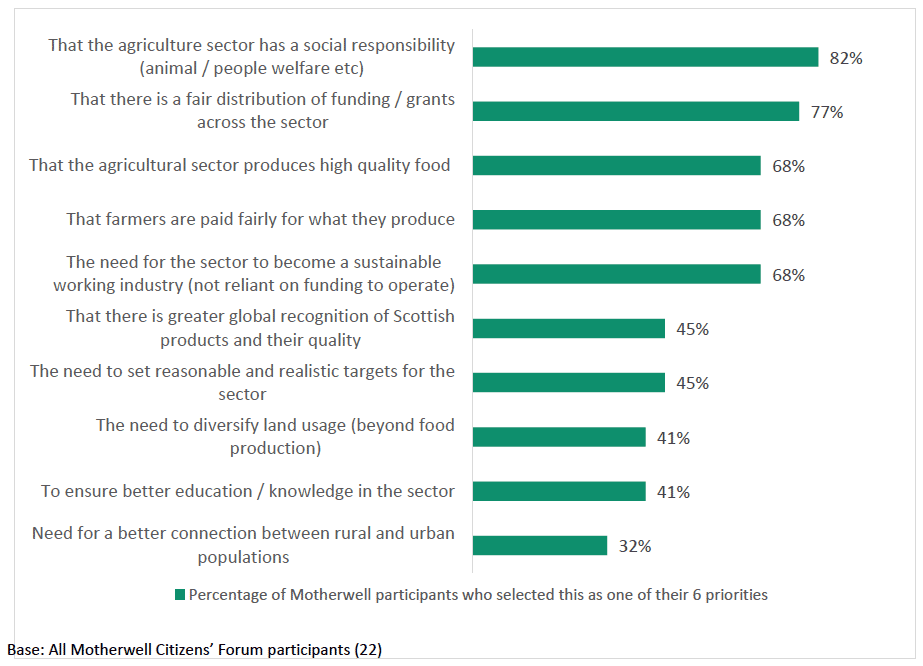
The highest-ranked principle was around the idea of the agricultural sector having a wider 'social' responsibility towards the welfare of people and animals (supported by 82% of participants). While only chosen by 45% of participants as a priority the importance of any targets set for the sector being 'realistic and reasonable' was also a key focus in these discussions. This related to the recognition that the sector is already heavily regulated (in relation to environmental management, food standards and animal welfare) and, although improvements might be valued farmers still needed to have the chance to operate viable businesses.
"The biggest eye-opener for me is the many demands already being made of the farming community."
Of Motherwell participants, 68% prioritised supporting the need for the agricultural sector to become a sustainable working industry (not reliant on funding to operate). This was envisioned by participants as being an industry that "future-proofed," providing a steady food supply and meeting the needs of the population while taking into account the climate and environment. This was also linked to the priority expressed by 68% of participants that producers are paid fairly for products, ensuring that the sector is able to operate in a cost effective way and therefore "limit subsidies." Alongside this however, 77% prioritised the need for there being a fair distribution of any funding/grants across different agricultural sectors (although at this stage there was no consensus drawn about what would be considered 'fair').
"Agriculture is diverse and should remain so - farmers need help to sustain the availability of foods, the viability of rural communities and protect the environment."
68% of participants also prioritised that the the Scottish agriculture sector should be one producing high-quality food for local consumers and for export. This reinforces the further principle that agriculture policies should support and promote a global recognition of "high quality" Scottish products and establish Scotland as being amongst "world leaders" in best practices in the agriculture sector (prioritised by 45% of participants)
"Need to remember that our environment provides us with food, recreation, beauty - gives us a feeling of wellbeing and helps our mental health."
In Motherwell 41% of participants also prioritised the diversification of agricultural land usage beyond producing food, such as by "embracing niche markets", developing farm shops, farm visits or home-stay offers as ways of developing additional income. Another aspect of the discussion that informed this principle was the opportunities created by investment in environmental improvements towards "making our landscape attractive" in ways that would encourage greater rural tourism, or using less productive land to generate energy instead of food.
In Montrose
In predominantly rural Montrose, participants developed 13 principles which were then ranked (with each participant again able to select 6 principles to prioritise).
Principles for future agricultural policy developed at the Montrose citzens' Forum
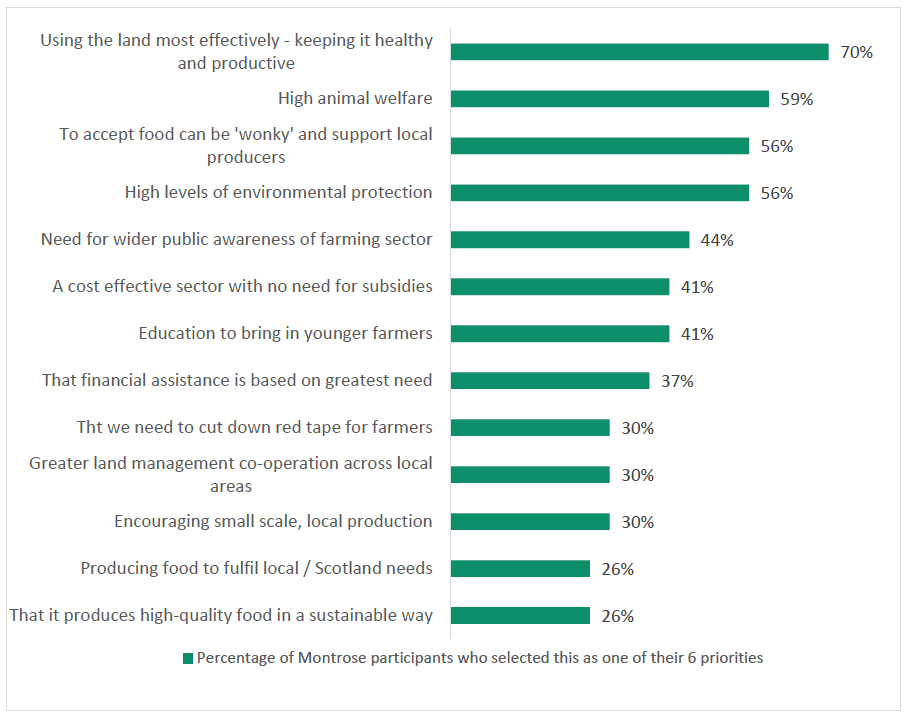
The highest ranked principle in Montrose, prioritised by 70% of the participants, was that the way farmland is used across Scotland was done in ways that were most effective for ensuring it remained healthy and productive. Participants talked about more use of crop rotation and maintaining the health of the soil to maximise the potential of the land. The need for high environmental protection standards was also prioritised by 56%. Here the discussions focussed on the idea that the agriculture industry has a key role in "environmental stewardship" of the land on behalf of the wider community, with 30% of participants identifying that better co-operation on land management and activities to protect and conserve the natural environment may be a way to improve impacts.
"Learned about farmers input to biodiversity and that farming practices can actually help with the environment."
Of participants in Montrose, 59% prioritised the need for high animal welfare standards in Scottish farming, and explained that this should also be demonstrable to the public to help encourage responsible local purchasing. 56% of participants also prioritised the need to accept imperfections in food appearance if that meant you could buy fresher, local produce.
"Need better clarity on animal welfare and what different welfare labels mean e.g. organic"
This focus on local food production, and the need for local support of the sector, was also emphasised in the prioritisation of the production of high quality food in sustainable ways and ensuring that food produced in Scotland was meeting local demands by 26% of participants, including the possibility of "encouraging local production of locally specific foods." Finally the principle of encourage small scale local production was also prioritised by 30% of participants in Montrose, saying that it might help produce "stable source of employment for people."
"Important for us to consider more where our food is coming from and how we are supporting local farmers"
Another 44% prioritised the need for the sector to be able to operate in cost effective and efficient ways, reasoning that if farmers were getting fair prices for their produce, and not losing money, that there would be an overall reduced need for subsidies. Further 37% of participants in Montrose prioritised the principle that any financial assistance given to the sector should be done so on the basis of where there was the greatest need "rather than blanket grants."
"More stability in market prices of products e.g. milk would be of lasting value to the sector more than just grants"
Finally, of the Montrose Citizens' Forum participants, 44% prioritised the principle of ensuring wider public awareness of the farming sector, and the complexities and challenges they face. 41% prioritised the need for education to bring in young farmers and attract new blood into the industry, something many of the participants had first hand awareness of this being a challenge in rural environments as the tradition of passing farms down within a family was breaking down. 30% of participants also identified that cutting down on the amount of red-tape for farmers would allow them to focus more on the core business of using and protecting their land.
Funding to support farmers and food production
On the Sunday mornings participants had a final opportunity to hear from Professor David Hopkins, Dean of the Central Faculty at Scotland's Rural College in order to learn about how the Common Agricultural Policy (CAP) contributes to the Scottish agricultural sector. The purpose of his presentation was to:
- Outline the history and purpose of funding through the Common Agricultural Policy;
- Explain the proportion of funding currently offered to different types of activities (the pillars) and the current rationales for that;
- Explain how funding allocations are prioritised between types of farms.
Participants then heard from Professor Davy McCracken, Professor of Agricultural Ecology at Scotland's Rural College about how different choices in the allocation of this funding in the future could have an impact on the environmental, food production and economic outcomes of agricultural land management in Scotland.
After a question and answer session with these experts' participants worked in their small discussion groups to consider the criteria on which funding should be allocated to support farming and food production.
In the research survey at the beginning of the weekends participants had been asked a variety of questions to establish baseline opinions on the need for support to the farming sector. In that survey:
- 93% agreed (with 71% strongly agreeing) that Scottish farming is vital for the success of the Scottish economy
- 43% disagreed (with 8% strongly disagreeing) that Scottish farmers receive a fair share of money for the food they produce
- 16% of participants thought a key government focus in relation to future agricultural policy should be on guaranteeing a minimum level of income for farmers
- It is also worth noting that in all cases the highest levels of sentiment came from participants in the Motherwell Forum, which had the higher proportion of urban participants.
When asked to consider different criteria for providing funding to farmers to support food production the question asked in the national survey was drawn upon to allow for comparative analysis. Thus, participants were presented with the following question:
Currently, CAP money that goes to farmers is distributed according to a range of factors, most importantly the size and potential productivity of the farmland, the highest payment rate goes to the largest farms on better quality land. What would be your preference for how any future budget should be distributed?
In the national survey 30% of respondents had selected 'budget based on maintaining a stable farming industry' as their preferred option, making it the preferred option overall. There was some concern in the review of these results that this may simply have been the safe and/or easy option to choose, so for the Citizens' Forums this option was not included in order to dig deeper into the reasons people gave for either wanting change or maintaining the status quo.
This meant that the options presented to participants were:
1. Allocation based on farm size, with smaller farms and crofts receiving a greater share than at present
2. Allocation based on activity taken to advance environmental goals
3. Allocation based on quality of land, with those farms with poor quality of land or mountain land receiving the greater share
4. Allocation based on the type of farm (for example dairy, vegetable, etc.) and related demand in Scotland
5. Allocation based on the health aspects of the food produced
6. Allocation based on farm size, with larger farms with better quality land receiving the highest payments (as now)
While some of the participants complained that there was not an option to advocate for no funding to be given to subsidise farms, most participants agreed that the sector is currently so reliant on this type of support that farmers would struggle to maintain a viable business if it suddenly was withdrawn. Removing any future equivalent of the types of support farmers received via CAP was therefore seen as something that could cripple the sector in the short term. Further participants tended to agree that this would remain the case unless there were significant changes made to the price's farmers receive for their produce and the attitude of the public (and the export market) as to what are seen as acceptable food prices.
Preferred Criteria
After spending time evaluating each of the criteria in turn within their discussion groups participants in the Citizens' Forums completed a private ballot, indicating their top 3 preferences.
1st preference votes from member of the Citizens' Forum on their preferred criteria for support to farmers
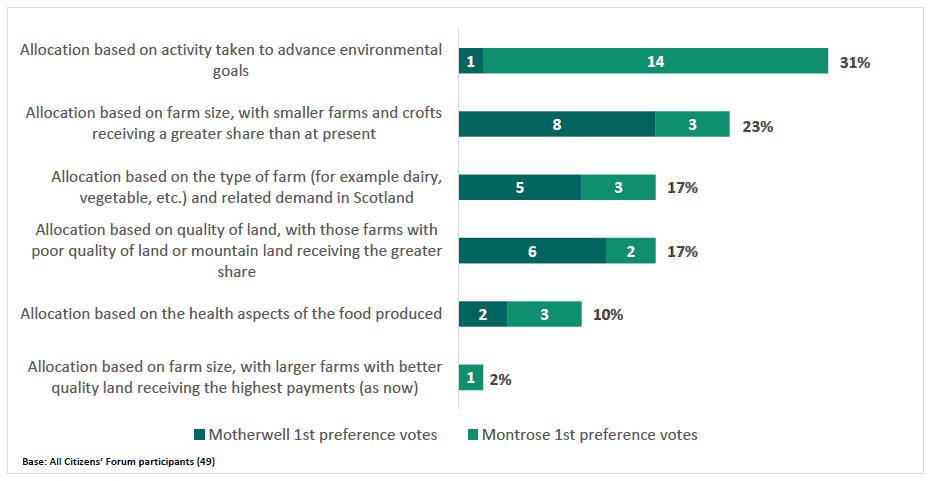
That any future funding allocation to farmers should be based on the activity taken within their food production activities to 'advance environmental goals' was the favoured option across the Forums as a whole. It should be noted however that this was because almost half of the participants in the Montrose Citizens' Forum chose this as their first option, aligning clearly with the principles they established for evaluating options which prioritised environmental performance. Only one participant in the Motherwell Citizens' Forum identified this as their preferred option, highlighting the different emphasis given to environmental performance within food production activity in these discussions.
Key reasons given for prioritising this criteria for funding were that it integrates food production with environmental concerns, "looks after the quality of the environment" and "increases knowledge of environmental goals". There were however some concerns expressed that this option could favour bigger landowners who had more options of what to do on their land to mitigate their environmental impacts and therefore "may put smaller lands at a disadvantage". Some participants also felt that a policy based on this criteria would discriminate against certain types of farms, e.g. cattle farming, where it is intrinsically harder to minimise the environmental impacts of their farming activities.
Allocations based on farm size 'with smaller farms and crofts receiving a greater share than at present' was the most consistent preference from participants in the Motherwell Citizens' Forum. This reflects much of the focus of their wider discussions and the principles they established which gave strong support to maintain a diverse farming sector.
Many of the arguments in favour of this approach focused on the need to maintain a place within the sector for small, independent farms and crofts as "just now they are struggling, and we are losing smaller farms / crofts creating more unemployment and poverty". It was also noted that "bigger farms have more opportunity for diversification (and to do things differently) camping, more variety of crops and livestock, farm shops, petting zoos, farm stays etc." as a reason why there should be more support for smaller landholdings. Related comments included "small farms are important (not want to be like banks and the big ones only)" and that the current allocation policy reflected the "same old story, we don't look after the wee man."
For those who prioritised the type of farm, and its relevance to food demands in Scotland, as their preferred criteria the main reasons were that then production "would be needs driven" and have the flexibility to respond to "changing consumer need". For some this was a vital focus because the foods that are part of our stable diet would be those receiving the subsidies (if needed) and they argued that, as a result of this, "self-sufficiency should follow - if it is managed correctly based on product demand".
Concerns, however, were also raised that this model could be "counter indicative" to some of the wider priorities expressed as "bigger farms may focus on staple outputs" and as such create "less diversity as more profitable farms are preferred". Participants also noted the risk of "overproduction if quotas not set" and recognised that, given the low proportion of quality arable land in Scotland, that there were practical limitations on how the land could be used by farmers for different types of "in-demand products".
Allocation of funding based on land quality, with those farms with poorer quality of land receiving the greatest support (i.e. the opposite to the current situation) was prioritised by 17% of participants. This was largely on the basis that it seemed a fairer allocation of funding towards those farmers who would struggle most to make their land profitable: "Scotland has poorer land and should get a greater allocation of the subsidy". Arguments in favour of this criteria also recognised that famers working poorer quality land, particularly in highland and island communities, may also serve other wider socio-economic functions, for example as anchor employers within rural areas and that subsidy therefore could have wider, positive knock-on impacts.
There was, however, also a counter argument presented that suggested land quality itself was not enough to demonstrate entitlement. Rather, in this case, it was argued that a demonstrable commitment to maximising the value of their land was required before any further entitlements were offered: "farmers on poor quality land should not get greater support unless they can show that they are undertaking activities to diversify the productivity of their land."
Finally, the current system of funding which rewarded the size and quality of the land farmers held, was generally not supported by participants in the Citizens' Forums, receiving only 1 first preference vote. This was largely based on the sense that this model of funding supported those who "should be able to help themselves", although there was also a sense of security in retaining a tried-and-tested model: "better the devil you know".
When preferential votes were considered there was little change in the overall ranking of the options, although the weight of opinion balanced out between the first and second preference, as can be seen in the graph below. Support for the current system of funding allocation however remained low, suggesting that participants were generally interested in seeing change, despite the lack of consensus regrading what that change should be.
Preferential votes on preferred criteria for support for the farming sector
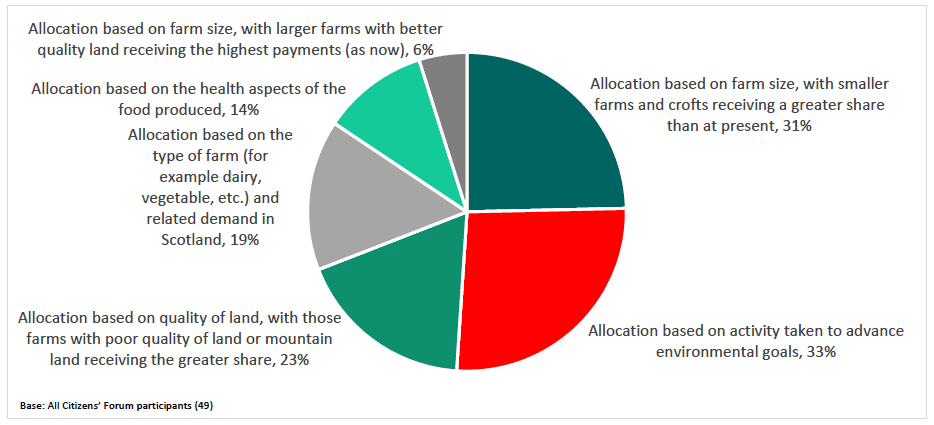
Finally, the table below demonstrates the impact that the deliberative process, i.e. 2 days of learning and considering the issues, had on the participants' final preferences.
Comparative look at how first preferences for how the balance of funding should be distributed between CAP priorities[82]
| Allocation based on farm size (as now) | Allocation based on farm size, with smaller farms receiving a greater share | Allocation based on activity taken to advance environmental goals | Allocation based on quality of land, with poorer quality of land prioritised | Allocation based on the type of farm produce - related demand in Scotland | Allocation based on the health aspects of the food being produced | |
|---|---|---|---|---|---|---|
| Survey | 6% | 26% | 10% | 9% | 8% | 8% |
| Pre-deliberation | 8% | 37% | 22% | 8% | 10% | 14% |
| Post-deliberation | 2% | 23% | 31% | 17% | 17% | 10% |
Here it can be seen that, following the deliberative process, providing support for those able to demonstrate environmental improvements grew notably. Further there was a doubling in support given to providing funding to farmers with lower quality land in order to help sustain the diversity of the sector and, by default, support rural communities.
How future funding allocations to agriculture, environment and rural development might be balanced differently
In the final discussion session of the Citizens' Forums participants were asked to consider how the future balance of funding allocations might be differently apportioned between the three broad CAP priority areas. Again, drawing on the way the questions were framed in the national survey, participants were presented with the following question:
The Common Agricultural Policy currently has three priorities:
1. to support farmers and food production to help ensure safety and stability
2. to support the natural environment during food production
3. to help protect rural communities.
What would be your preference be for the balance of future spending between these priorities?
They were given six options to evaluate and then rank in order of preference:
1. Prefer to see all three priority areas receive the same amount
2. Prefer to see a greater share going to support the natural environment and to help protect rural communities
3. Prefer to see spending remain as it is currently (c. 70% to farmers and food production)
4. Prefer to see a greater share going to support farmers and food production (more than the current 70% of CAP)
5. Prefer to see the largest allocation going to support the natural environment
6. Prefer to see the largest allocation going to help protect rural communities
When participants were asked to vote individually on these options following their discussion there was an overall consistency on how the votes were distributed between the Citizens' Forum locations. The graph below shows the distribution of 1st preference votes across the two Citizens' Forums.
1st preference votes from member of the Citizens' Forum on their preferred balance of funding allocations to farming and food production, environmental management and supporting rural communities.
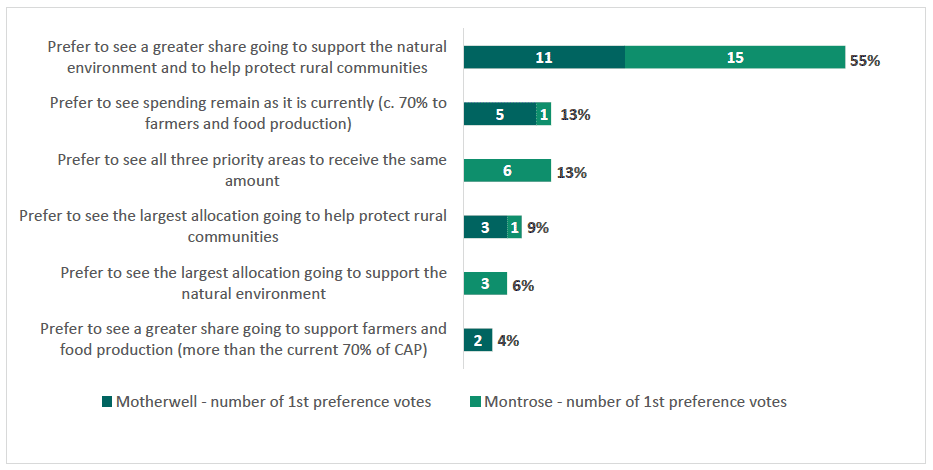
Overall, more than half (55%) of the first preference votes went to seeing a greater share of funding going to 'support the natural environment and to help protect rural communities. During discussions, participants pointed out that a greater proportion of support given to rural communities more broadly "would encourage tourism", help "diversify business" and support "other business development" in rural communities. It was also seen as a way to "repopulate/sustain countryside population." Caution to this preference included a possible "negative perception by other communities (e.g. urban/fishing industries)" and that, given what they had learnt about the important role that subsidies has played in maintaining an active farming sector in Scotland, it "should not be at a disadvantage for farmers."
Following on, 13% of first preference votes went to seeing 'all three priority areas to receive the same amount of funding'. This was noticeably only voted for by participants in Montrose. This may, in part, be because these participants, by the very nature of living in a much more rural environment, have a greater innate understanding of the interplay between the agricultural sector and the other economic and business demands of rural communities. This option therefore sat particularly well between their wider awareness and their prioritised principles regarding relating to environmental stewardship and keeping the land both healthy and productive. Here is was described as being a 'fair' way to balance out the competing needs of the farming sector, the environment and rural communities more broadly.
Participants across both of the groups however identified impacts and reasons both in favour and against this policy. While some participants stated that maybe this would result in a "wishy-washy" compromised policy, others argued that "the same amount is fairer (no preferential treatment)." One of the key objections was that, while there was no question this balance of funding would be good for sustaining rural communities, there are "other ways to support rural communities" (including that they "should get funding from local authorities") and that the funding currently distributed through CAP should focus specifically on agricultural lands. Comments relating to this emphasis on farming and food production emphasised that "food has to be a priority" and that there is a "risk to farming if the overall budget [available to them] becomes too small".
Seeing 'spending remain as it is currently (70% to farmers and food production)' received 13% of the first preference votes overall. This also seems to reflect the growing recognition participants had gained throughout the weekend of the role subsidies have played in supporting Scottish farming and the potential impacts on the agricultural sector if this was removed. Comments from participants on these options tended to argue that, while keeping the current system may seem "unfair" and "not fit for purpose", it would provide "stability" and is "needed to keep high standards."
Only 4% overall supported the idea of increasing the proportion of funding directly allocated to farming and food production. When talking about this, participants tended to focus on the ability of funding to lead to "more jobs in farming", "cheaper food," more "variety of food," and "could increase quality standards." Participants also felt that it could help with "diversification of the land use" or "help make the land more profitable" for example through "an emphasis on local produce for local people or for high quality export markets".
On the other hand, opponents to these models expressed the view that such continued spending "could emphasise/enable sub optimal production patterns" and "rewards people just for having land, not for what they do with it." One table in Montrose went as far as disagreeing unanimously with the idea of increasing the percentage of CAP funding available for farmers and food production, saying it was simply "not up for discussion" as the industry was already far too reliant on public money and needed to either develop sustainable business models or cease to operate.
Only 6% of participants' first preference went to seeing 'the largest allocation going to support the natural environment.' While there had been an almost universal interest in reducing the environmental impacts of the farming sector the majority of participants seem to have balanced this demand, when it came to the proportional allocation of funding, with an acknowledgement that food production was at the heart of farming and without an emphasis on supporting this other priorities became less relevant. In the discussions participants therefore tended to acknowledge that, while a significant increase in funding for environmental protections would "be great for the natural environment" and that it is an area that "needs more investment", too much emphasis placed here would mean that overall "farmers would struggle", it could "kill off farming" and that "no focus on food production is a negative."
There was very little change in the overall results when second and third preference votes are included. Preferring to see a greater share of funding going towards the environment and rural communities remains the most popular preference albeit with a smaller percentage than with just first preference votes (at 27%). This, alongside the fact that the second highest ranked option was that of splitting funding equally across the three priorities, suggests an overall consensus among participants that it was important to rebalance the allocation of funding between the different priority areas. Complementing this was the proportionally low levels of support for increasing the proportional allocation made to support farmers and food production (7%), although sustaining current spending patterns did receive 14% of the votes.
Preferential votes on the balance of funding allocations to farming and food production, environmental management and supporting rural communities.
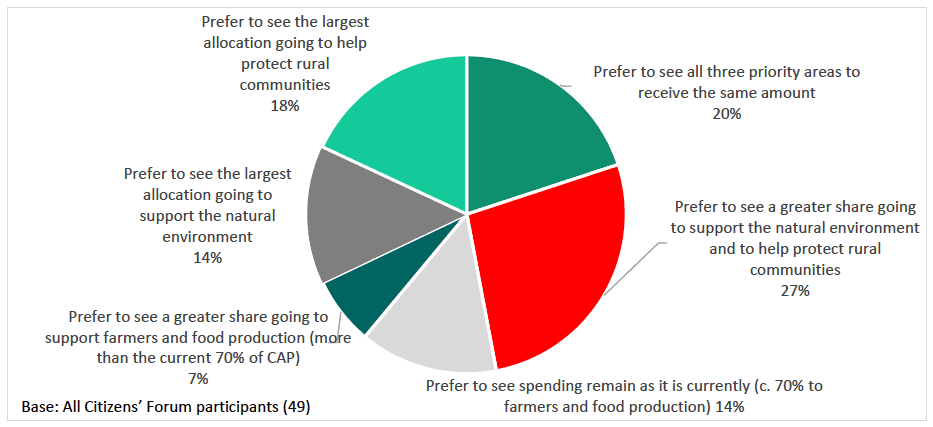
Finally, the table below demonstrates the impact that the deliberative process, i.e. 2 days of learning and considering the issues, had on the participants' final preferences. At the beginning of the process their initial response to the question about the balance of funding between farms and food production, environmental support and rural communities as it appeared in the national survey was quite similar to the larger survey results. There was somewhat higher priority given to 'support the natural environment and to help protect rural communities' than in the national survey, particularly from participants in Montrose as may be expected, but aside from that the pattern of preferences was the same.
By the time they were casting their final votes on this topic however the pattern had significantly changed. 55% recorded that their first preference was to see 'a greater share going to support the natural environment and to help protect rural communities' (for the reasons given above). It is also worth noting that support for an equal distribution of funding between the three areas, the top priority identified in the national survey, had dropped by half (although initially given significant support). The option of the balance of a greater share being given to support farming and food production was also broadly rejected by participants, with only 2 people giving it their vote in the final ballot.
First preferences for how the balance of funding should be distributed between CAP priorities
| Prefer all three priority areas to receive the same amount | A greater share going to support the natural environment and to help protect rural communities | Prefer spending to remain as it is currently | A greater share going to support farmers and food production | The largest allocation going to support the natural environment | The largest allocation going to help protect rural communities | |
|---|---|---|---|---|---|---|
| Survey | 26% | 17% | 15% | 9% | 9% | 6% |
| Pre-deliberation | 31% | 31% | 16% | 12% | 6% | 4% |
| Post-deliberation | 13% | 55% | 13% | 4% | 6% | 9% |
Contact
There is a problem
Thanks for your feedback